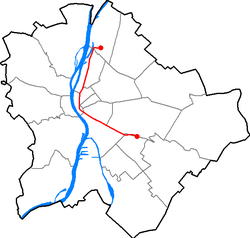Line 3 (Budapest Metro)
| Line 3 | |||
|---|---|---|---|
 |
|||
| Overview | |||
| Stations | 20 | ||
| Line number | Line 3 ("Blue metro") | ||
| Technical | |||
| Line length | 16.5 km (10 mi) | ||
| Track gauge | 1,435 mm (4 ft 8 1⁄2 in) | ||
| Electrification | 825 V DC | ||
| Operating speed | 80 km/h | ||
|
|||
The Metro 3 (Officially: M3, North-South Line, Unofficially: Blue Line) is the longest line of Budapest Metro. It runs in a general north-south direction parallel to the Danube on the Pest side, roughly following Váci út south from Újpest to the city center, then following the route of Üllői út southeast to Kőbánya-Kispest. Its daily ridership is estimated at 626,179. Like Metro 1, it does not serve Buda.
The first decree for the third line was made in 1968, construction started in 1970, the first section was opened in 1976 with six stations. The southern direction was complemented with five more stations in 1980, and the northern one in 1981, 1984, and 1990 with nine stations, reaching its current length of 20 stations and 16.5 km (10 mi), the longest line in Budapest. Soviet-made 81-717/714 carriages (prevalent in many Eastern Bloc metro systems) operate on this line. Operation started with 4 units in 1976, expanded to 6 units in 1984. Six unit-trains provide space for 1,097 people. It was planned for a daily ridership of 800,000 people.
M3 runs in a north-south direction (more exactly, from north-northeast to southeast) through the city and connects several populous microraion with the downtown. It has a transfer station with Line 1 and Line 2 at Deák Ferenc tér, and a transfer station for Line 4 at Kálvin tér.
Mayor of Budapest Gábor Demszky was warned in 2006 by BKV that the line would soon need reconstruction, but no steps towards this were made before the new mayor István Tarlós took office in 2010. The trains started burning or smoking multiple times, but this has caused neither fatalities nor serious injuries as of yet. Tarlós reacted by ordering the retirement of all trains that were more than 40 years old. He also started the reconstruction of the tracks, because they were also reported as hazardous. In 2014 the mayor's administration finished laying out the plans for the complete reconstruction of the line and Viktor Orbán's government allowed the local government to finance the reconstruction of the trains by taking up loans. Repayment of the loans was guaranteed by the national government in case the municipal government was not able to pay.
...
Wikipedia

